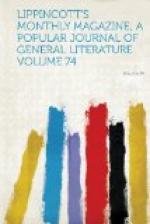As we crossed the great esplanade to the north of the Fort—Bhima Gandharva and I—and strolled along the noisy streets, I began to withdraw my complaint. It was not like Jonesville. It was not like any one place or thing, but like a hundred, and all the hundred outre to the last degree. Hindu beggars, so dirty that they seemed to have returned to dust before death; three fakirs, armed with round-bladed daggers with which they were wounding themselves apparently in the most reckless manner, so as to send streams of blood flowing to the ground, and redly tattooing the ashes with which their naked bodies were covered; Parsees with their long noses curving over their moustaches, clothed in white, sending one’s thoughts back to Ormuz, to Persia, to Zoroaster, to fire-worship and to the strangeness of the fate which drove them out of Persia more than a thousand years ago, and which has turned them into the most industrious traders and most influential citizens of a land in which they are still exiles; Chinese, Afghans—the Highlanders of the East—Arabs, Africans, Mahrattas, Malays, Persians, Portuguese half-bloods; men that called upon Mohammed, men that called upon Confucius, upon Krishna, upon Christ, upon Gotama the Buddha, upon Rama and Sita, upon Brahma, upon Zoroaster; strange carriages shaded by red domes that compressed a whole dream of the East in small, and drawn by humped oxen, alternating with palanquins, with stylish turnouts of the latest mode, with cavaliers upon Arabian horses; half-naked workmen, crouched in uncomfortable workshops and ornamenting sandal-wood boxes; dusky curb-stone shopkeepers, rushing at me with strenuous offerings of their wares; lines of low shop-counters along the street, backed by houses rising in many stories, whose black pillared verandahs were curiously carved and painted: cries, chafferings, bickerings, Mussulman prayers, Arab oaths extending from “Praise God that you exist” to “Praise God although you exist;”—all these things appealed to the confused senses.
The tall spire of a Hindu temple revealed itself.
[Illustration: HINDU TEMPLE IN THE BLACK TOWN, BOMBAY.]
“It seems to me,” I said to Bhima Gandharva, “that your steeples—as we would call them in Jonesville—represent, in a sort of way, your cardinal doctrine: they seem to be composed of a multitude of little steeples, all like the big one, just as you might figure your Supreme Being in the act of absorbing a large number of the faithful who had just arrived from the dismal existence below. And then, again, your steeple looks as if it might be the central figure of your theistic scheme, surrounded by the three hundred millions of your lesser deities. How do you get on, Bhima Gandharva, with so many claims on your worshiping faculties? I should think you would be well lost in such a jungle of gods?”




